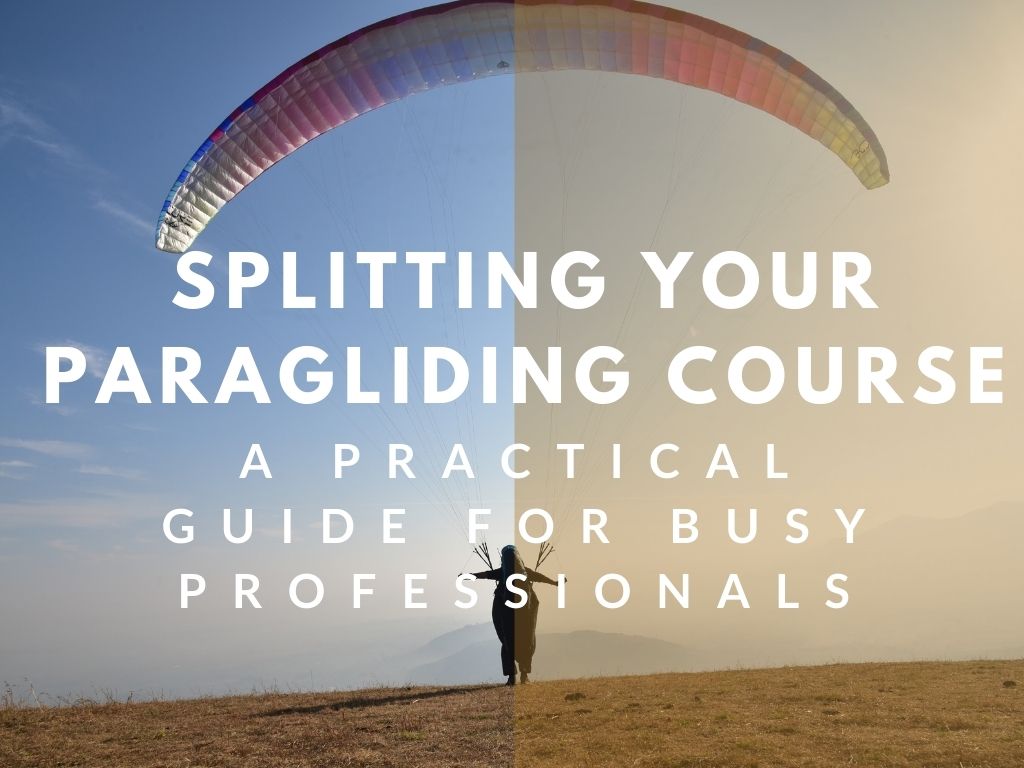Paragliding is a life-changing adventure—a chance to embrace the skies and connect with a sense of freedom like never before. For many working professionals, though, the challenge isn’t the flying itself—it’s finding the time to train. With busy schedules and limited leave, splitting your paragliding course into shorter sessions is often the most practical solution. And the good news? It’s completely doable!
Gaps in training aren’t just common—they’re part of the nature of a sport like paragliding, which relies on weather conditions, personal readiness, and steady progression. By understanding how to navigate these gaps, you can make the most of your training journey while balancing the demands of your everyday life.
Why Splitting Your Course Works
- Flexibility for Your Lifestyle
If you’re juggling a career, family, or other commitments, splitting your course allows you to train at your own pace. Short training sessions give you the freedom to enjoy paragliding without needing extended time off from work. - No Rush
Paragliding is about building confidence and enjoying the process, not rushing through it. Taking your time allows you to fully absorb each stage of training. - A Natural Part of the Sport
Paragliding training often involves waiting for the right weather, which can naturally cause breaks between sessions. These pauses aren’t setbacks—they’re opportunities to reflect, review, and recharge before your next flight. - Easily Manageable Gaps
With proper planning and refresher training, any gaps in your course are easy to bridge. Many pilots successfully complete their training over weeks or months without any issues.
The Cons of Splitting Your Paragliding Course
- Skill Retention Challenges
Paragliding relies on muscle memory and confidence, both of which can fade with long gaps between sessions. This might require additional practice or refresher training to get back on track. - Loss of Momentum
Consistent practice is essential to building skills and confidence. Splitting the course can disrupt your rhythm, making it harder to pick up where you left off. - Extended Course Duration
Dividing the course inevitably increases the time it takes to complete, delaying your ability to progress to solo flights or advanced training. - Weather-Related Delays
Paragliding is weather-dependent. Spreading sessions out over time increases the chance of encountering delays due to changing seasons or unfavorable conditions. - Adjustment Periods
After a long break, it may take some time to readjust to the physical and mental demands of paragliding, which could slow your progress.
What We Offer to Support Your Training Journey
- Stay Engaged During Breaks
Use the time between sessions to review training materials, watch videos, and mentally visualize the techniques you’ve learned. Staying connected to the sport keeps your skills fresh. - Refresher Training: Your Safety Net
If a longer gap occurs, refresher training is designed to help you get back to the level you left off. These sessions focus on revisiting key skills, equipment handling, and flight techniques to ensure a smooth transition.
Our Recommendations for Splitting the Course
- Complete the Basic Course in One Stretch, If Possible
The initial basic course is your foundation. Completing it in one go (P1 in 4 days) is the best way to build confidence and momentum. - Shorter Gaps Are Better
While gaps are common, shorter breaks between sessions help maintain your muscle memory and rhythm. If possible, aim for a consistent training schedule. - Go at Your Own Pace—Safety First
Paragliding isn’t a sport you can rush. Take your time to learn, progress, and gain confidence at a pace that feels right for you. Safety and enjoyment should always come first. - Embrace the Process
Every pilot’s journey is unique, and breaks in training are part of the adventure. Accepting this makes the process more enjoyable and less stressful.
Why Splitting Training Reflects the Spirit of Paragliding
Paragliding is all about embracing the rhythm of nature and adapting to the elements. Training with gaps mirrors the essence of the sport—being patient, present, and prepared for when the time is right to take off. Whether your course takes a week, a month, or even longer, what matters most is your commitment to the journey and your passion for flying.
Final Thoughts: Gaps Are Part of the Adventure
Having a gap in your paragliding course isn’t a hurdle—it’s just part of the journey. Whether it’s waiting for the perfect weather, managing work commitments, or balancing family responsibilities, these breaks are a natural part of learning to fly. With flexibility, proper planning, and support from experienced instructors, you can complete your training at your own pace and still enjoy every moment.
Remember, the sky will always be there, ready to welcome you when you’re ready to fly. Take your time, trust the process, and savor every step of this incredible adventure. The freedom of flight is worth it!
Ready to start your journey or plan your next training session?
Get in touch with us—we’re here to guide you every step of the way!
